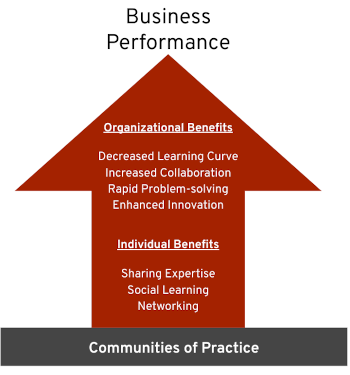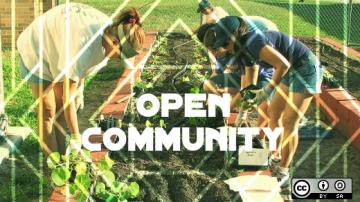As I discussed in the first part of this series, community is a fundamental principle in open organizations. In open organizations, people often define their roles, responsibilities, and affiliations through shared interests and passions—not title, role, or position on an organizational chart.
So fostering and supporting communities of practice (CoPs) can be a great strategy for building a more open organization. Members of communities of practice interact regularly, discuss various topics, and solve problems collectively and collaboratively. These communities provide members with an opportunity to share their expertise, learn from others, and network with one another.
As Luis Gonçalves states in Learning Organisation:
CoPs provide a shared context where members of the organisation can communicate and share information; stimulate learning through peer-to-peer mentoring, coaching, self-reflection, and collaboration; generate new knowledge; and initiate projects that develop tangible results.
But those aren't the only value such communities can offer. Communities of practice can also enhance an organization in the following ways (summarized in Figure 1).
Decreased learning curves. Many organizations face the challenge of rapidly increasing productivity of new employees (or members). This task becomes especially challenging in organizations where an employee's manager may be located in a different state, country, or region. Communities of practice offer new employees a network of connections they can tap into more quickly and easily. By joining a CoP, they can immediately access a network of experts and share resources, ask questions, and seek guidance outside the formal lines of the organizational chart.
Increased collaboration. A recent survey from My Customer.com shows that 40 percent of company employees report not feeling adequately supported by their colleagues—because "different departments have their own agendas." A lack of collaboration between departments limits innovation and increases opportunities for miscommunication. Communities of practice encourage members from all roles across all departments to unite in sharing their expertise. This increases collaboration and reduces the threat of organizational silos.
Rapid problem-solving. Communities of practice provide a centralized location for communication and resources useful for solving organizational or business problems. Enabling people to come together—regardless of their organizational reporting structure, location, and/or management structure—encourages problem-solving and can lead to faster resolution of those problems.
Enhanced innovation. Researchers Pouwels and Koster recently argued that “collaboration contributes to innovation." CoPs provide a unique opportunity for members to collaborate on topics within their shared domains of interest and passion. This passion ignites a desire to discover new and innovative ways to solve problems and create new ideas.

Figure 1: Benefits of communities of practice. Courtesy of Tracy Buckner. CC BY-SA.
Étienne Wenger, an educational theorist and proponent of communities of practice, said that learning doesn't only occur through a master; it also happens among apprentices. Communities of practice foster learning by connecting apprentices, while encouraging collaboration and offering an opportunity for creative problem-solving and innovation.
In the final article of this series, I'll explain how you can reap these benefits by creating your own community of practice.








1 Comment